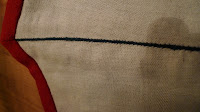The middle of November arrived and the time for the course came. I had finished the embroideries on the vest and the skirt of the bunad dress, so that I could use the course learning how to assemble the bunad. I thought that one weekend should be sufficient to finish the assembly, but was sadly mistaken. Most of the vest was to be sewn by had, and so were the wrinkles on the skirt. I soon realized that I needed to focus my efforts around learning the things I did not know beforehand, so that I knew all I needed to assemble the bunad after the course. That turned out to be a good strategy, and I learned many ingenious old skills and smart new tricks.
The first seem I needed to learn was the “rib seam”. I thought it was a decorative seam, but it was not. What it was, was, however, ingenious. With a rib seam, you can sew two peaces of cloth together, and at the same time sew the lining on to the vest in one seam (see picture to the left). That meant that it was possible to sew three seams in one seam, and it looked absolutely lovely as well. The seam was truly ingenious.
The second seam I needed to learn was the “tverregls”. I had no idea what this was, but it was to be sewn onto the slit of the skirt. It turned out to be another ingenious old skill. The aim is to reinforce the slit so that it will not tear if you have an accident when putting on your bunad. The idea is to sew button hole stitches (application stitches) along the bottom of the slit, and reinforce this with a string parallel to the bottom of the slit (see picture to the right). The string is sewn by 4-5 loose stitches across each end of the slit, approximately one centimetre above the bottom, and then grouped together with application stitches to make a nice cord.
The last thing a dreaded was the wrinkle stitches, which should be sewn by hand, thee rows, with exactly 0,5 cm between stitches and across rows. If the seem is not exact, the wrinkles will turn out bad. I imagined a long and painstaking job, but the course supervisor knew some tricks. She found a block of squared paper and started to cut strips of paper and pin them to the edge of the skirt. Then, it was only to follow the squares on the paper, and the stitches were perfectly wide and spaced apart (see picture to the left).
We had a long, informative and very nice weekend. Now, I am working hard to finish the assembly of the bunad. I have to hurry, since there is still much embroidery to do before I can attend the next bunad assembly course I have signed up for, due in January. Then, hopefully, I will learn how to assemble the shirt and the jacket (for which I have no assembly instruction). I really look forward to learn more old skills and new tricks.
















































